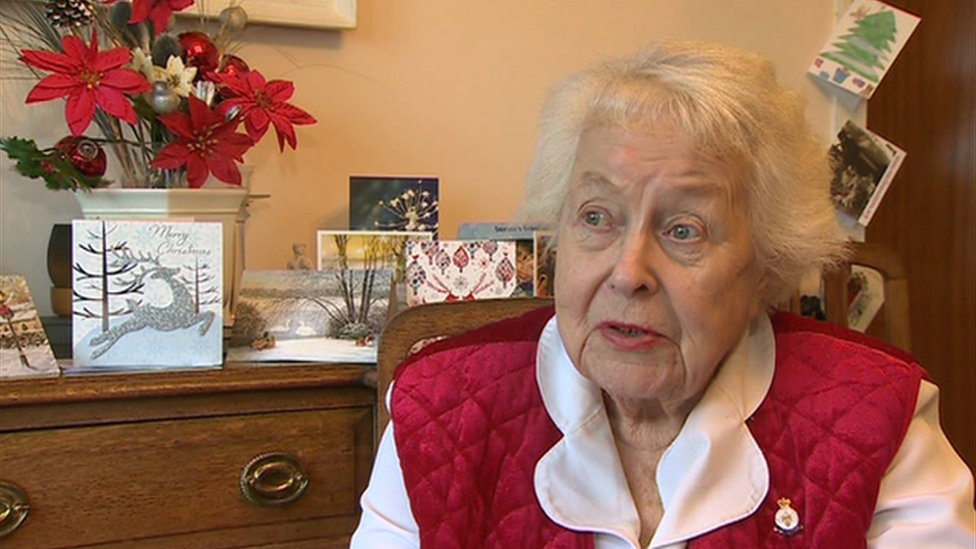World War Two: Robert Harris V2 novel inspired by Eileen Younghusband
- Published
BBC Wales Today spoke to Eileen Younghusband in 2011 about her war efforts
A woman's work to stop German missile strikes during World War Two was the inspiration for a best-selling author's new book.
Eileen Younghusband, of the Women's Auxiliary Air Force (WAAF), was posted to Belgium in 1944 to help track launch sites of the deadly V2 missile.
Robert Harris decided to write V2 after reading her obituary following her death, aged 95, in 2016.
Harris said she had a "wonderful story" he'd previously never heard about.
By the end of 1944, it looked like Nazi Germany was going to lose the war, but Adolf Hitler had one more secret weapon up his sleeve - the world's first long-range, guided ballistic missile, the V2.
Britain had already endured the V1 missile, but that was slower and could be shot down. The V2 was more sophisticated and travelled into space before coming back down at three times the speed of sound. It was designed to devastate British cities.
The first attack on London, on 8 September 1944, gouged a crater 10m (32ft) across, killing three people and injuring 22.
It was one of more than 1,300 V2s fired at Britain and, as allied forces advanced, hundreds more were targeted at Belgium and France.
Although there is no exact figure, estimates suggest several thousand people were killed by the missile - 2,724 in Britain alone.
Harris' new novel tells the story of how the bombs were made and launched - and the attempts by British agents to discover where they were coming from and to destroy them.
A character in the book is based on the work done by Ms Younghusband, of Sully, Vale of Glamorgan.
'Quite extraordinary'
Speaking to the BBC, Harris said he happened to read her obituary in The Times, after her death in Cardiff, four years ago.
"She was one of those women who worked in the filter room of RAF fighter command and she was sent out in November 1944 as a part of the British effort to try and stop the V2s landing on London.
"They were launched from the coast of Holland, they hit London within five minutes.
"Eileen was sent to Belgium, to a little town called Mechelen, just recently liberated. Her job was to sit in a bank vault with a slide rule and try to collate the parabolic curve of the V2, so that the RAF could hit the launch sites - they were mobile.
"It just struck me as a wonderful story about a woman doing something quite extraordinary that I'd never heard of before and that's what really started me on it."

Eileen Younghusband moved to Wales in 1984 and became known for her campaigning on health and education issues
Born in London, Ms Younghusband moved to Wales in 1984. Speaking to the BBC in 2011, she explained her role in tracking down the V2 launch sites.
"Our job was to extrapolate the curve of the V2 from the place it landed back to the launch site and we did that once we knew the fall of shot and we got the position of the top of the curve," she said.
"We then used a slide rule and geometry to find the launch site and they managed to destroy them all by the end of February, beginning of March, 1945."
Ms Younghusband published her autobiography in 2009, saying at the time the women she served with in the WAAF never felt their work had been recognised.
She began a series of books and talks about her wartime experiences and her work, One Woman's War, won a People's Book Prize.
Her exploits won her an army of admirers, including the former First Minister Carwyn Jones.
In 2012, Ms Younghusband was awarded the British Empire Medal for helping to campaign against cuts in adult education.
The former BBC Wales journalist Hugh Turnbull was a friend.
He said: "Eileen would be thrilled to know Robert Harris has written a book about her.
"The last five years of her life were very busy. She was writing, giving talks to 1,000 people at the Hay Festival and was always in demand for radio and TV interviews."
- Published3 September 2016

- Published29 December 2012